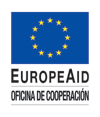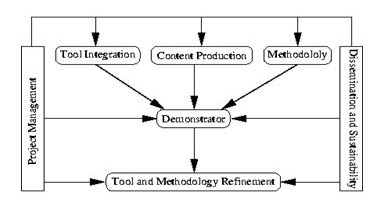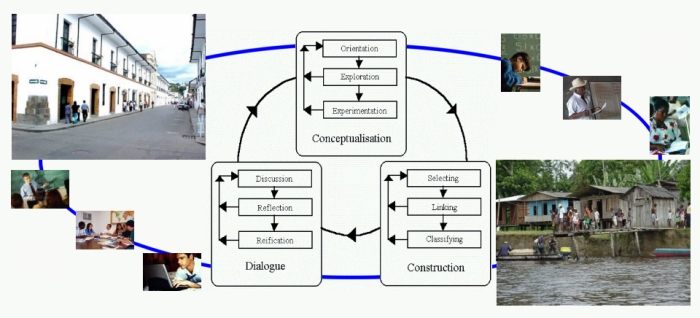University of Cauca
School of Electronic and Telecommunication Engineering
Department of Telematics
Group of Telematic Engineering
Project: E-LANE - European and Latin American New Education.
| Versión en español |
![]()
Funded by:

|
European Union - @LIS Programme. Grant Contract ALA/2002/48-264/2082. |

|
Enter to EVA, Entorno Virtual de Aprendizaje (Learning Virtual Environment) of the University of Cauca, based on the platform developed by E-LANE |
Main researchers (University of Cauca):
- Dr. Álvaro Rendón G. (Group of Telematics Engineering).
- Eng. Mario Fernando Solarte (Group of Telematics Engineering).
- Dr. Magnolia Aristizabal (Department of Education and Pedagogy).
- M.Sc. Cristina Simmonds (Center for Open an Distance Education).
- M.Sc. Clara Luz Forero and Reinaldo Velasco (Department of Agroindustry).
Participant organisations (Visit the consortium official web page):
- Universidad Carlos III de Madrid (UC3M), Spain.
- Universidad Estadual de Campinas (UNICAMP), Brazil.
- Universidad de Chile (UChile), Chile.
- Universidad del Cauca (Unicauca), Colombia.
- Telefónica Investigación y Desarrollo (TID), Spain.
- Groupe des Ecoles des Télécommunications – Institut National des Télécommunications (GET/INT), France.
- Universidad Galileo (UG), Guatemala.
- Trinity Collage Dublin (TCD), Ireland.
- Instituto Tecnológico y de Estudios Superiores de Monterrey (ITESM), México.
- University of Reading (UR), Union Kingdom.
OBJECTIVE
To promote an integrated learning environment in the framework of the information society, both at academic and non-academic training level. The project proposes the development of an open platform obtained through the integration of solid applications already used in the context of e-learning as an open software e-learning platform, the design of an innovative teaching methodology oriented towards this platform, and course content from some of the most prestigious educational institutions in Europe and Latin America, with the objective of providing the society with educational material of excellent quality at low cost.
SPECIFIC OBJECTIVES
-
Open software e-learning platform. The integration of current state-of-the-art information technology related to e-learning to provide an open software platform with minimum hardware requirements providing the essential functionality to teach courses in different disciplines and scenarios (presential vs. non presential, synchronous vs. asynchronous).
-
Innovative methodology. Equally important to the software platform is an innovative methodology that capitalizes on the new resources provided by technology. More precisely, both the way in which courses are taught, as well as the way material is prepared needs to be taken into account if it is to be used in the context of e-learning. From this point of view, the consortium counts on experienced partners with a proven history of successful projects that will deploy these new methodologies and resources in the context of the provided platform. This methodology takes into account the scenario in which a person needs Life Long Education.
A second aspect that is crucial to developing material is accommodating the required infrastructure to be able to achieve a high degree of reuse. All the universities participating in the consortium are well-established educational institutions, and therefore they provide a large amount of content for courses that need to be integrated to achieve maximum impact when deployed.
-
Courses Content. A concrete set of courses will be produced in order to be taught with the proposed tool and methodology. By combining the effort of the partners, already proven course material will be made available to implement the appropriate courses that address the educational needs of the Latin American societies. The fact that five Latin American partners from five very different countries compose the consortium provides de ideal scenario to create content with a lot of variety and test it in a wide variety of situations ranging from conventional university environments to communities with special needs.
-
Impact Measurament and Refinement. Social impact is of the biggest importance. The objective of the proposal is to maximize such impact; therefore, a carefully planned evaluation stage is essential. In this phase, all the required methods will be made available to gauge with as much precision as possible which parts of society most benefit from the courses, if they have been efficiently implemented, the required resources, their contribution to improve the surrounding environment, etc.
-
Dissemination and Sustainability. This objective is oriented towards extending the impact of the platform, not only for the students that receive education with it, but also the entire educational and scientific community. The fact that the platform will be distributed with an open software license will significantly contribute to its dissemination. Other technology areas have been greatly benefited by tools distributed with such licenses. E-learning should not be an exception. In fact, this dissemination is expected to grow when more and more users and institutions are capable of exchanging solid and effective course material.
STRUCTURE OF THE PROJECT
The overall project structure is directly derived from the objectives and shown by the following illustration:

The total duration of the project is 36 months, and it is organized in seven sub-projects, each one of which has a clearly established objective:
- Subproject 1: Project Management and Quality Assurance.
- Subproject 2: Tool integration in the e-learning platform.
- Subproject 3: Educational content production.
- Subproject 4: Definition of the methodological framework.
- Subproject 5: Platform, contents and methodology demonstration.
- Subproject 6: Tool, contents and methodology refinement.
- Subproject 7: Dissemination and sustainability.
![]()
Go back to the web page of Group of Telematics Engineering
